|

Summer 2000 (8.2)
Pages
42-45
Mystery of the
Sunken Castle Sabayil
Many
Questions Still Plague Archeologists
by the late Sakina Nasirova, State Historical-Architectural
Museum
"Bayil Tower - around which only legends were wandering
yesterday - has become a historical truth today." - Sakina
Nasirova
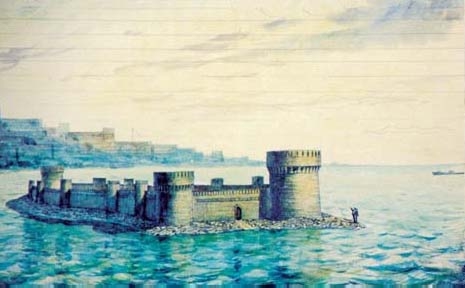
Photo: Model of the Sabayil
Castle near Baku Bay.
_____
The mysterious Sabayil castle has appeared in Azerbaijani legends
and stories for centuries. One legend refers to a city located
on the banks of the Caspian Sea, governed by a beautiful woman
named Sabayil. One day, while looking at the sea from the top
of a tower, she saw a handsome man swimming toward her and fell
in love with him. When this man - named Zegh - swam out to meet
Sabayil, he fell in love with her at first sight as well. They
met everyday, and their love made Zegh stronger and stronger.

But one day Zegh met another woman and fell in love with her,
too. This took away his strength. When he swam to Sabayil's tower,
the waves engulfed him and separated him from her. Sabayil could
not bear this sorrow, so she hurled herself into the sea. The
people named the fortress Sabayil in honor of its governor.
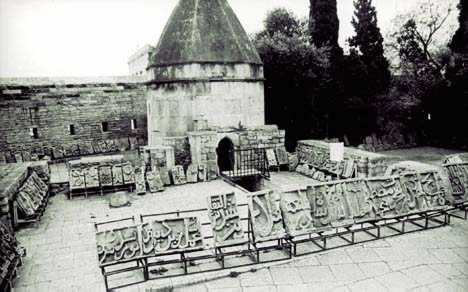
Above: Courtyard of the Shirvanshah
Complex where sections of the Sabayil castle frieze are on display.
Another legend connects Alexander the Great with a city named
Sabayil. Isgandar (Alexander the Great) wanted to capture a certain
city on the banks of the Caspian, but the inhabitants of the
city would not yield. So Isgandar asked advice from his teacher,
Aristotle. The city was located below sea level, and a large
stone prevented water from flowing into the city. Aristotle invented
a special liquid that would transform stone into lime. With this
liquid, Isgandar penetrated the stone. Water began to flow into
the city and flood it. The inhabitants fled to the town of Gilan
in order to save their lives. The flooded city was named Sabayil.
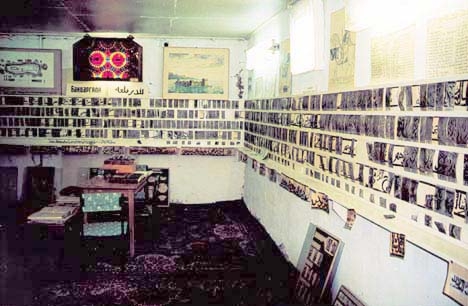
Photo: Workshop near Shirvanshah
Complex in the Inner City where Sabayil archeological findings
are displayed.
The Real Castle
How did the original castle called Bayil Gasri disappear? According
to ancient chronicles, there was a large earthquake in the Caspian
Sea in 1306. Perhaps the sea level rose enough to submerge the
castle and the island it was built on.
Throughout the millennia, the water level of the Caspian has
fluctuated dramatically. From 1723 up until the early 20th century,
the sea level was receding. Beginning in the 1930s, it became
possible to see the ruins of a castle underwater. In quiet weather,
people could tell that the castle had stone tablets with writing
on them. Sabayil was no longer just a legend - it was a real
castle, built on a small island in the Baku bay, about 300 meters
offshore.
The Institute of History at the Academy of Science researched
the fortress, a project that took 30 years (1939 to 1969). Researchers
found that even basic questions were difficult to answer, such
as: What was it for? When was it built? Who built it?
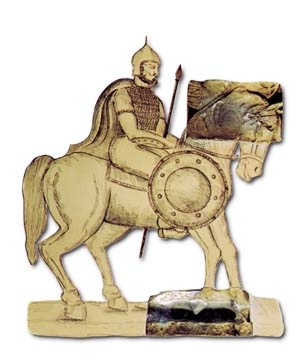 A Mighty Fortress A Mighty Fortress
The 180 x 40 m castle had a trapezoidal shape that extended from
north to south. Surrounding the castle were walls with semi-circular
towers that probably served as watchtowers. The castle's walls
were 1 1/2 to 2 meters thick, which suggests that the building
may have been used as a defense tower, just like Baku's famed
Maiden's Tower.
According to Sara Ashurbeyli, 95, a well-known Azerbaijani historian,
Sabayil is the castle mentioned by Abdurrashid Al-Bakuvi, a 15th-century
geographer who said that the castle was destroyed during the
13th-century Mongol invasion.
Al-Bakuvi, a native of Baku, wrote in 1430 in his "Kitab-talkhis
el-asar ve el-melik el-gahhar": "Baku has two castles,
very strong, built of stone. One of them is very large and on
the shore [Maiden's Tower]. This is the castle that the Mongols
could not conquer. The other is further offshore. Its upper parts
have been destroyed."
Fragments of the frieze of Sabayil Castle: Photos: Khanlou.
Ashurbeyli says that the Mongols did not have a fleet of ships,
so they were not able to completely conquer the Sabayil castle.
But the building was considerably damaged during the attack.
According to Eastern sources, the Mongols were not able to take
Baku for quite a long period of time. When the town was attacked,
the upper parts of the castle were destroyed by the Mongols'
siege machinery.
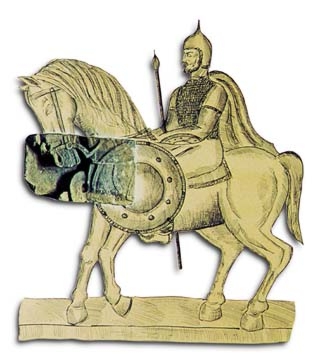 Written in Stone Written in Stone
After spending centuries underwater, not much of Sabayil's original
structure is left. Only the foundation remains, along with close
to 700 stones that have writing carved on them. The largest of
these stones measures 70 x 15 x 50 cm.
The stones circle the upper parts of the castle walls. Most of
their script is in Persian, the state language at the time. The
carvings record the genealogy of the Shirvanshahs, starting with
Fariburz, who apparently initiated the construction of the castle.
Titles like "shah" and "sultan" are carved
on the stones along with the names of various towns. Ten of the
stones begin with the word "bismillah" - "In the
name of God" - a traditional Muslim saying.
In addition to the script, there are images of human faces, animals
like oxen, dogs, camels and birds, as well as mythological images.
The pictures of animals are believed to signify the years that
the various Shirvanshah rulers were in power. In the medieval
East, each year was associated with a specific animal. One bas
- relief shows a life - size warrior sitting on his horse, a
type of carving that would have typically decorated the entrance
to a castle.
More Clues
One of the first indications archeologists had of the castle's
age was from a coin found inside its walls. The coin was minted
during the first quarter of the 13th century, during the rule
of Shirvanshah Fariburz III (1225-1243).
Archeologists were able to figure out that the castle once had
nine rooms, two of them with hearths. Researchers also found
fragments of black and red clay vessels that had been used for
cooking. The surface of the vessel fragments was typical of pottery
from the 12th and 13th centuries. Also, there were fragments
of pipes of various diameters, which are believed to be water
pipes.
One of the bas - reliefs records a date - the year 632 hijri
(on the Muslim calendar) - which corresponds to 1234-1235. This
may indicate the year that the construction of the castle was
completed.
Researchers are still trying to find out what purpose the Sabayil
castle once served. One suggestion that the castle was a fire-worshipping
temple used by the Zoroastrians doesn't seem to fit. Another
hypothesis - that the structure was used as a caravanserai -
doesn't work either, because the gate was too small for camels
to fit through.
Many scholars believe that the castle was once used as a sea
defense castle. Ashurbeyli believes it was used as a customs
office in peacetime. "The castle was a military customs
post in peaceful days, and merchants were received here,"
she says. "Possibly merchants even stayed there. Ships could
moor to this castle. The entrance was so narrow that horses and
camels could hardly pass through it. Probably the goods were
unloaded from ships to the castle and then taken onshore on horses
and camels through the straits. When the straits were submerged,
the goods could have been shipped on boats."
To see for yourself what the Sabayil castle is believed to have
looked like, visit Baku's Shirvanshah Complex. Outside on display
in the courtyard are castle stones that were brought up from
under the sea, though a considerable number of the stones that
make up the frieze are still left at the bottom of the Caspian
and have not been brought up yet. Lack of funds prohibit further
investigation. Nearby the Shirvanshah Palace is a simple museum
workshop with a model of what the mysterious Sabayil castle probably
looked like.
Sabayil Castle
Fragments of the frieze are displayed in the outer court of Shirvanshah
Palace in the Inner City (Ichari Shahar). Ask for the Bayil Castle
Laboratory established by the State Historical Archeological
Museum located adjacent to the Palace complex.
The late Sakina
Nasirova was interviewed by Betty Blair in 1997. Jala
Garibova also contributed to this article.
From Azerbaijan
International
(8.2) Summer 2000.
© Azerbaijan International 2000. All rights reserved.
Back to Index
AI 8.2 (Summer 2000)
AI Home
| Magazine Choice | Topics
| Store
| Contact
us
|